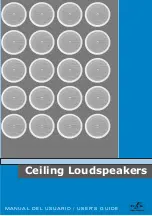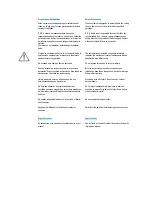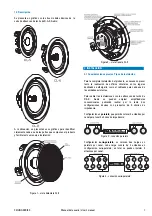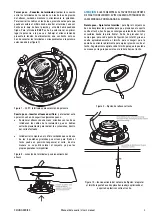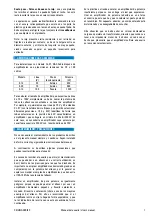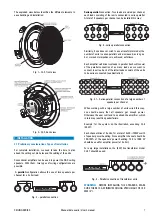
CEILING SERIES
Manual del usuario /
User's manual
9
Step 5 – Screwing and fixing
: to fix the assembly to the
ceiling, the tabs have to be rotated and lowered. This is done
by tightening the corresponding screws clockwise. The first
quarter turn rotates the tab into position and out of the guide;
the rest tightens the tab down onto the back of the ceiling
surface. The process needs to be repeated for all four screws.
Fig. 9 – fixing the speaker to the ceiling
Fig. 10 – fixing system: when tightening the screw the
mounting tab comes down, pressing the plastic support
against the ceiling.
Step 6 – Replace the grille
: once the speaker is fixed to the
ceiling, this is the only operation left.
Push the grille into place until fixed. You will need to use the
adhesives stripes provided.
Note: the grille shows some degree of resistance to be
removed. Fixing is by contact, so there is little clearance
between its inner diameter and the inner support, so that
some force needs to be applied when removing it.
3. DAS AMPLIFIERS TO BE USED
For model CL-5T installations, some DAS Audio amplifiers
provide 70 and 100V outputs.
Model Line
(V)
Mode Power
(W)
E-12 50 Stereo
650
E-20 70 Stereo
960
E-12 100 Bridge
1220
To calculate the required amplifier power for a 70 or 100V line,
simply sum the input power selection of all speakers
connected to a given amplifier channel. Example: for a 70V
line with 40 units of CL-5T (with multi-tap transformer that
offers a selection of 1.5,3 and 6W) which are all set to 6W,
the total speaker power handling will be 40x6=240W. The
only requirement is that the total speaker power is below the
amplifier’s output power.
4. MAINTENANCE, USE
No maintenance is needed for the products in this manual if
they have been installed correctly and following the
instructions in this manual.
Some usage tips follow:
The best maintenance for a speaker is its correct use, i.e.,
within the design parameters. It is important not to utilise
amplifiers that are too large when compared to the speaker
power. In general, it is recommended that you use an amplifier
with an output that is 100% to 150% of the speaker's average
(RMS) power rating. That way we have headroom for the
dynamics of real music and vocal signals, and at the same
time deliver a cleaner signal to the speakers that will result in
a more reliable system. Avoid using too small an amplifier.
The clip light of your amplifiers should never be on
continuously. This will distort the signal and may damage the
speakers. In fact, severe clipping is an easy way to burn a
speaker’s voice coil. At most, the clip light could blink
occasionally. When clipped, signals sound distorted and
produce listening fatigue quickly.
Never use a total impedance load that is lower than the
lowest impedance that an amplifier will take. Virtually all
professional amplifiers will accept loads down to four ohms
safely in stereo mode. Many are rated for two ohm loads but
often will run into overheating protection when used this way,
particularly in high ambient temperature and high output
power applications. Never connect more speakers to an
amplifier's channel than it will take, i.e. do not load a channel
with total impedance that is lower than the minimum load
specified by the manufacturer.

